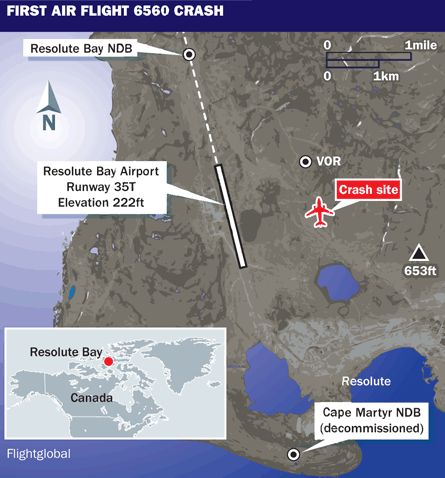Canadian investigators are trying to determine why a chartered Boeing 737-200, operated by a carrier familiar with harsh Arctic conditions, crashed on a hill offset from the runway centreline shortly after declaring it was on final approach.
The 36-year-old First Air twinjet, a combi fitted with gravel deflectors for unpaved runways, had been due to land at Resolute Bay in daylight on 20 August after a service from Yellowknife.
Both the cockpit-voice and flight-data recorders have been retrieved from the site of the accident. Three of the 15 occupants survived the crash, which claimed the lives of all four flight crew, 1.85km (1nm) east of the midpoint of Resolute Bay's single runway 17T/35T.
The runway has an elevation of 222ft (68m) with terrain rising to 600ft above sea level immediately to the east.
 |
|---|
Canadian forces had been in the immediate vicinity as part of the Operation Nanook 11 arctic capability exercise, which this year, ironically, was to test response to a major air disaster. A source supporting the exercise told Flight International he had been looking east from the airport apron as flight 6560 was due to arrive.
"I could not see the base of the hill opposite because the fog was too low," he said. The 737 had said it was on final instrument landing system approach to 35T, but when the tower controller requested a position update a few minutes later, there was no response, and a Beech 99 pilot - on approach to 17T - was asked to try to contact the flight, with no result. "I saw First Air ground crew waiting for the aircraft and wondering where it was," said the source, who added that an engineer thought he heard a spooling of jet engines, then a thump. No communication was heard during a check on the VHF distress frequency 121.5MHz.
The Beech executed a missed approach and continued south, before turning to follow the track to 35T on which the 737 had been inbound.
After it landed, said the witness, followed shortly by a De Havilland DHC-6, the fog began to lift and the improved visibility revealed smoke, flames and wreckage on the opposite hill.
A special weather advisory issued as soon as the wreckage was located indicated fog and a cloud base of 300ft, with winds from the south. Although there was a tailwind, there is no immediate indication that the 737 was intending to fly the back-course procedure and land on the opposite runway 17T.
The impact point is close to the VOR beacon for Resolute Bay, which is offset from the runway centreline by about 1.5km east.
Source: Flight International



















